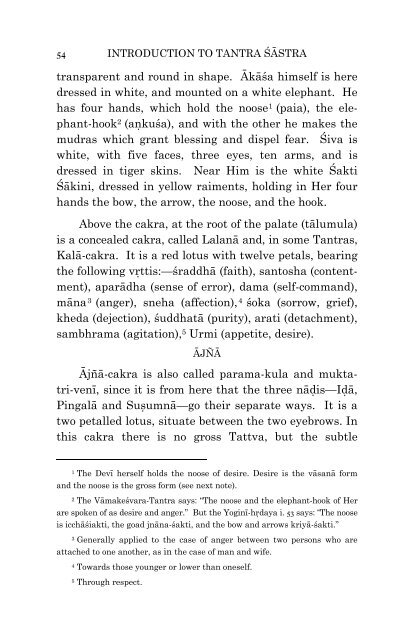Introduction to Tantra Sastra - Aghori
Introduction to Tantra Sastra - Aghori
Introduction to Tantra Sastra - Aghori
You also want an ePaper? Increase the reach of your titles
YUMPU automatically turns print PDFs into web optimized ePapers that Google loves.
54<br />
INTRODUCTION TO TANTRA ŚĀSTRA<br />
transparent and round in shape. Ākāśa himself is here<br />
dressed in white, and mounted on a white elephant. He<br />
has four hands, which hold the noose 1 (paia), the elephant-hook<br />
2 (aṇ kuśa), and with the other he makes the<br />
mudras which grant blessing and dispel fear. Śiva is<br />
white, with five faces, three eyes, ten arms, and is<br />
dressed in tiger skins. Near Him is the white Śakti<br />
Śākini, dressed in yellow raiments, holding in Her four<br />
hands the bow, the arrow, the noose, and the hook.<br />
Above the cakra, at the root of the palate (tālumula)<br />
is a concealed cakra, called Lalanā and, in some <strong>Tantra</strong>s,<br />
Kalā-cakra. It is a red lotus with twelve petals, bearing<br />
the following vṛ ttis:—śraddhā (faith), san<strong>to</strong>sha (contentment),<br />
aparādha (sense of error), dama (self-command),<br />
māna 3 (anger), sneha (affection), 4 śoka (sorrow, grief),<br />
kheda (dejection), śuddhatā (purity), arati (detachment),<br />
sambhrama (agitation), 5 Urmi (appetite, desire).<br />
ĀJÑĀ<br />
Ājñā-cakra is also called parama-kula and muktatri-venī,<br />
since it is from here that the three nāḍ is—Iḍ ā,<br />
Pingalā and Suṣumnā—go their separate ways. It is a<br />
two petalled lotus, situate between the two eyebrows. In<br />
this cakra there is no gross Tattva, but the subtle<br />
1 The Devī herself holds the noose of desire. Desire is the vāsanā form<br />
and the noose is the gross form (see next note).<br />
2 The Vāmakeśvara-<strong>Tantra</strong> says: “The noose and the elephant-hook of Her<br />
are spoken of as desire and anger.” But the Yoginī-hṛ daya i. 53 says: “The noose<br />
is icchāśiakti, the goad jnāna-śakti, and the bow and arrows kriyā-śakti.”<br />
3 Generally applied <strong>to</strong> the case of anger between two persons who are<br />
attached <strong>to</strong> one another, as in the case of man and wife.<br />
4 Towards those younger or lower than oneself.<br />
5 Through respect.

















